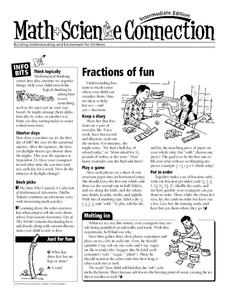Cornell University
Polymers: Instant Snow
Is it easy to make snow? Scholars use critical thinking skills as they investigate the concept of polymers by making snow. The class tests several different variables and takes measurements over the course of several days. They then...
Scholastic
Study Jams! Elements & Compounds
Compound class members' knowledge of elements and compounds with this delightful video clip! As the animated characters work on baking a birthday cake, they reveal that elements are simple substances that can be combined to form...
NASA
Mineral Mystery Experiment
One way to study something is to try to replicate it. Young scientists do just that as they use solutions to recreate mineral structures on a dwarf planet. They make solutions with different types of salt, evaporate them, and observe the...
PBS
Categorizing Matter | UNC-TV Science
Take the difficulty out of classifying matter with an easy-to-follow activity that makes distinguishing between pure substances and mixtures simple. Scholars explore how matter is grouped between two categories—pure substances and...
American Chemical Society
Different Substances React Differently
Looks don't tell the whole story. Young experimenters explore reactions with substances that look similar. They observe the reactions that take place when combined with baking soda and use indicators to conclude they react differently...
American Chemical Society
Gas Sudsation
Bring out some bubbly! Individuals perform the classic baking soda and vinegar experiment with a twist. Learners add a drop of dish detergent to make the bubbles last longer. They vary the amount of baking soda and vinegar in an effort...
American Chemical Society
Fizz Bizz
Bubbles seem to come from nowhere. Pupils investigate the formation of carbon dioxide bubbles in sodas. By placing different objects, including candies, in the soda, learners observe the formation of tiny bubbles on the surface of the...
American Chemical Society
Chemical Reactions and Color Change
Colors are more than just a pretty effect. Learners explore what color change means in terms of chemical properties and reactions. They create a pH solution using cabbage leaves and observe the changes when acids and bases are added.
American Chemical Society
Forming a Precipitate
Things are getting a little slippery in an inquiry-based lesson studying precipitates. Learners use soap and Alka-Seltzer tablets to create different mixtures with water. They then study the properties of the mixtures including their...
American Chemical Society
Exploring Baking Powder
Birthday cake wouldn't be light and fluffy without the chemical reactions between ingredients. Young scientists explore some chemical reactions in the 11th installment of a 16 lesson Inquiry in Action series. They determine the...
American Chemical Society
What’s the Difference between Baking Soda and Baking Powder?
Introduce pupils to chemical reactions. Using the hands-on lesson, learners experiment with substances that combine to form a gas. Different substances react to form different amounts of gas, leading to a discussion about the particles...
Museum of Science
Elephant Toothpaste
Get a surprised reaction from trying out the chemical reaction. Scholars conduct a chemical experiment by adding yeast to hydrogen peroxide and dish soap in a plastic bottle. They learn that yeast contains a catalase enzyme that releases...
NASA
Christa's Lost Lesson: Effervescence
How are chemical reactions affected by gravity? Learners explore the phenomenon of effervescence as part of the Christa's Lost Lessons series. They compare findings in an experiment on effervescence to a video of a similar experiment in...
Utah Education Network (UEN)
Utah Open Textbook: 5th Grade Science
How do Earth's changes affect humans? Pupils learn about physical and chemical changes on Earth and how they lead to erosion, earthquakes, and volcanoes. Using the text, they also explore the concepts of electricity and magnetism by...
Teach Engineering
Messin' with Mixtures
Do you separate your trail mix before eating it? Then you've been separating mixtures your whole life! Scholars model a contaminated soil sample using trail mix and estimate the percentage of each component. They consider how to clean up...
Teach Engineering
Properties of Mixtures vs. Solutions: Mix It Up!
Now it becomes crystal clear why the unit is called Mixtures and Solutions. The fifth installment of a six-part unit explores mixtures and solutions. After viewing a demonstration on mixing pebbles with water, salt with water, and...
Project WET Foundation
Soap and Water Science
Learn about germs without getting sick! An interactive resource prompts learners to identify the dirtiest surfaces on a city street. Class members then participate in a demonstration about washing dirty hands and how using soap can kill...
Resources for Educators
Fractions of Fun
Reinforce concepts and encourage learner engagement with a collection of math games, science experiments, and cross curricular activities. In one fun resource, learners sort objects, keep a diary of everyday fractions, play a game using...
Aquarium of the Pacific
States of Matter: Making Ice Cream
Who knew that learning about the states of matter could taste so sweet? This fun hands-on lesson captures the attention of learners as they use what they know about solids, liquids, and gases to create their very own batch of ice cream.
NASA
Is It Alive?
Determining whether or not something is living can be more difficult than it seems. Put your young scientists to work defining their own criteria to identify life, then work with three samples to see if they are alive or not.





















